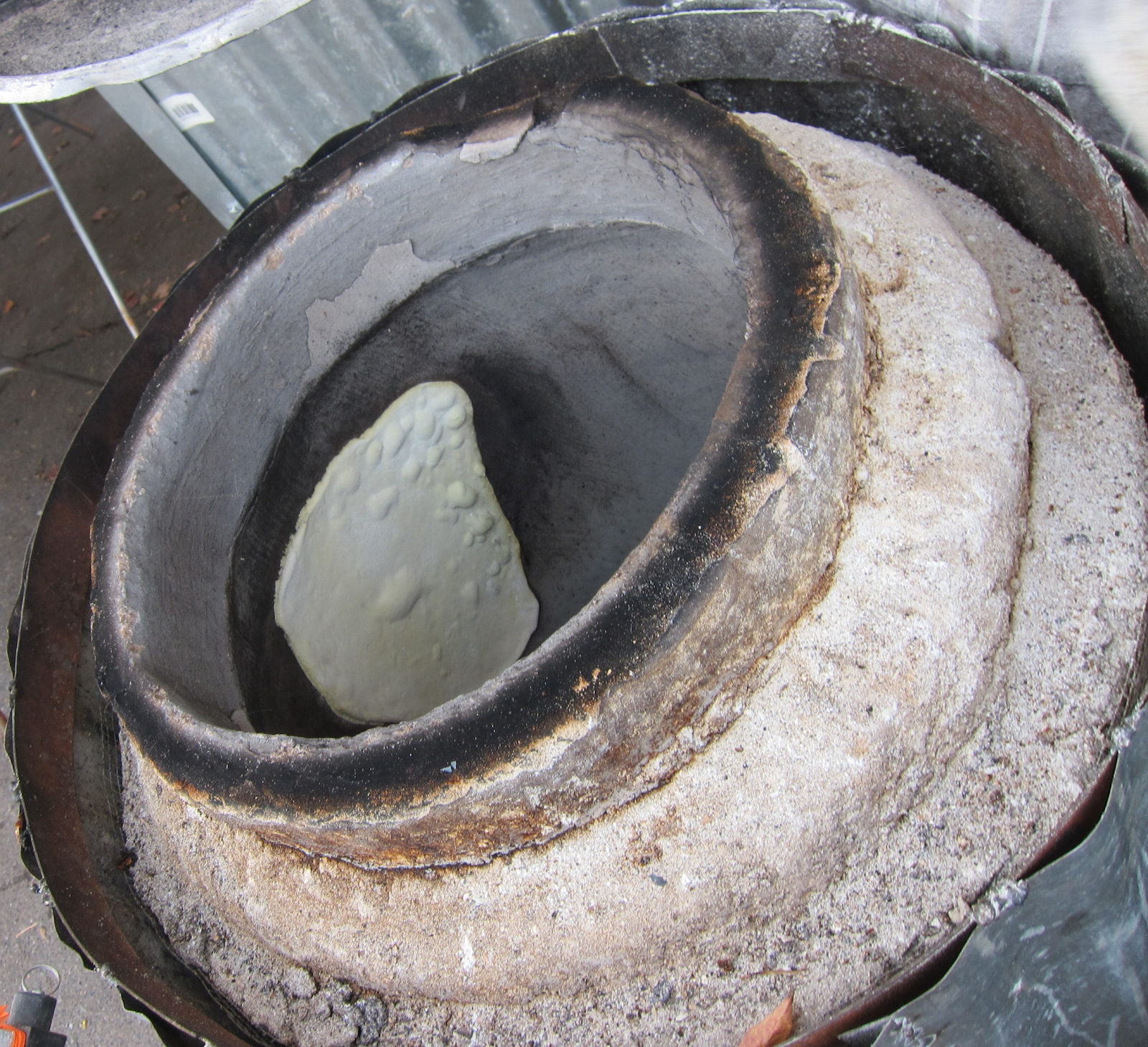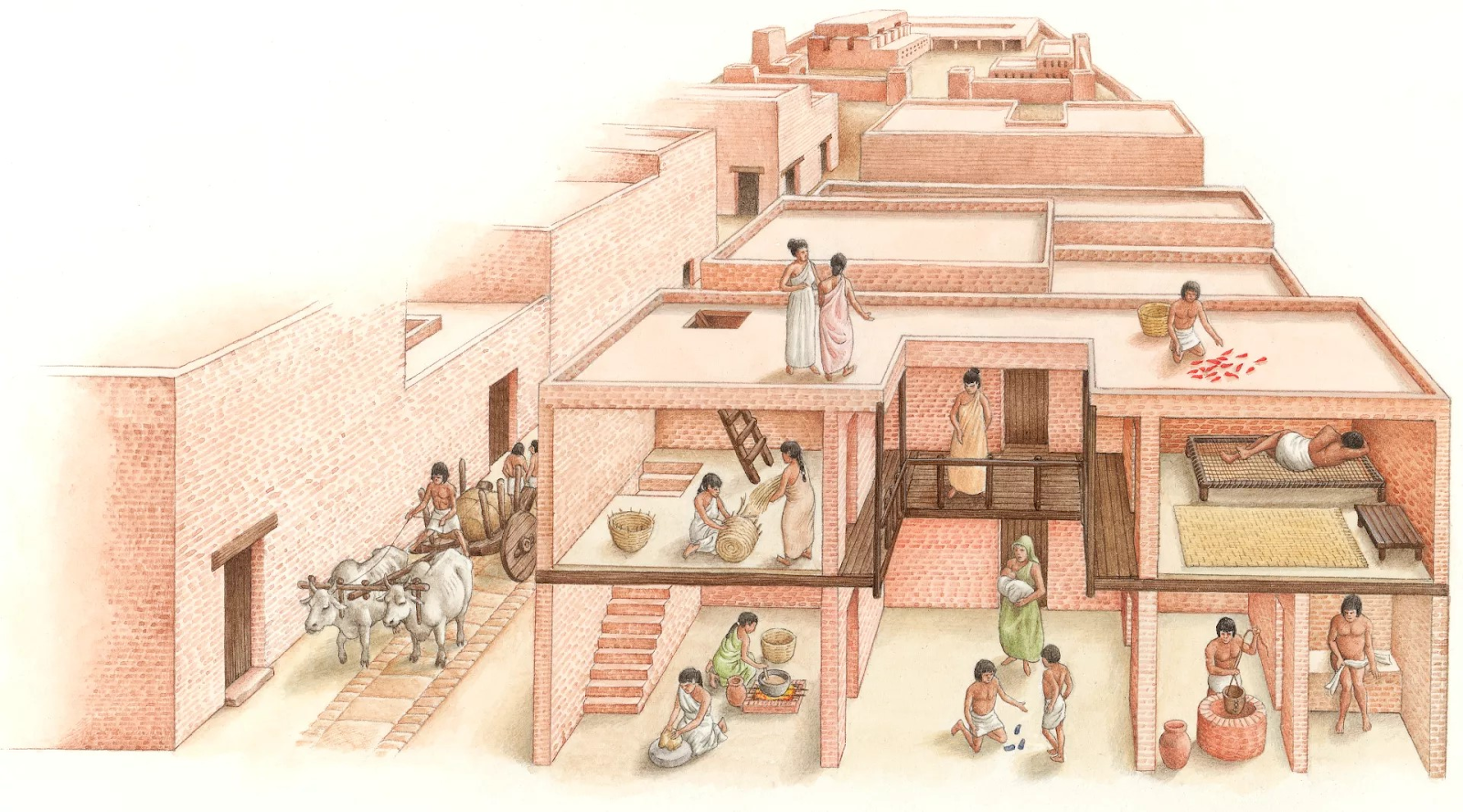"FOOD HABITS OF TAMILS" -PART: 17 "பண்டைய சிந்து சம வெளி உணவு பழக்கங்கள் தொடர்கிறது" / "Food Habits of Ancient Indus valley people or Harappans continuing" [தமிழிலும் ஆங்கிலத்திலும் / In English and Tamil]
சிந்து சமவெளி
நாகரிகத்தின்
மக்கள்
அனைவரும்
சைவ உணவு உண்பவர்கள்
அல்ல என்பதும், சைவ உணவுப் பொருட்களுடன்
சிந்து
சமவெளி
நாகரிக
மக்களும்
இறைச்சியை
உட்கொண்டனர்
என்பதும்
இறந்தவர்களுக்காக
வழங்கப்படும்
பிரசாதங்களில்
இறைச்சி
சேர்க்கப்பட்டுள்ளது
என்பதன்
மூலம் தெளிவாகவும் உறுதிப்படுத்தப்பட்டதாகவும் தெரிகிறது. மேலும் அங்கு மாட்டிறைச்சி, குறைந்தது
சிலராவது
சாப்பிட்டதற்கு
சான்றுகள்
உண்டு. அங்கு தோண்டி
எடுக்கப்
பட்ட தொல்பொருள்களில், ஒரு வேட்டையாடும் கருவியான,
சுண்டுவில்லில்
[கவண்வில்
அல்லது
கவட்டை / slingshot] பாவிக்கும் களிமண்
பந்துக்கள்,
மற்றும்
செம்பு
மீன் கொக்கிகள், அம்புவின்
நுனி, எறியும் கத்தி போன்றவை எடுக்கப்
பட்டுள்ளது.
அவை விலங்குகளை கொல்ல பாவிக்கப்பட்டு இருக்கலாம்
என்பதை
எடுத்துக்
காட்டுவதுடன்,
அவை மேலும் சிந்து
வெளி மக்கள் விவசாயிகளாக
மட்டும்
இன்றி, அவர்கள் ஆற்றல்
வாய்ந்த,
மற்றும்
திறமையான
வேட்டைக்
காரர்களாகவும்
மீனவர்களாகவும்
இருந்தனர்
என்பதையும்
சுட்டிக்
காட்டுகிறது.
இதுபோலவே
தானியங்களை
அரைக்கும்
கல்திருகைகள்
மொகஞ்சதாரோவில்
கண்டறியப்
பட்டுள்ளன.
லோத்தலில்
தந்தூரி
அடுப்பு
போன்ற சுடு அடுப்புகள்
காணப் படுகின்றன. இறைச்சி
பொதுவாக
கால்நடையில்
இருந்து
வந்தன. அவை ஆடு, மாடு, பன்றி, போன்ற கால் நடைகளுடன் மற்றும்
கோழி, ஆமை, பறவையும்
ஆகும். மேலும் எருமைகள்,
செம்மறியாடு,
ஆடுகள்,
மாடுகள்
போன்றவை
பால் எடுப் பதற்க்காக
வளர்க்கப்
பட்டன. அத்துடன் காட்டுக்
கோழி, காட்டு விலங்குகளான,
மான், மறிமான் (Antelope), காட்டுப்பன்றி போன்றவை
அங்கு வேட்டையாடப் பட்டன. ஆறு, குளம், கடலில் இருந்து
பெறப்படும்
உடன் மீன் [fresh fish], மட்டி போன்ற வற்றையும் அவர்கள்
உண்டார்கள்.
அத்துடன்
பல மீன்கள் காயவிடப்பட்டன
அல்லது
உப்பு இடப்பட்டன. மீனுடன்
அவர்கள்
பழங்கள்,
காய்கறிகள்
முதலிய
வற்றையும்
காயவைத்து
அங்கு நிலவிய கடுமையான
குளிர்காலத்தில்
பாவித்தார்கள்.
பாறை மீன், கெழுத்தி
மீன் போன்ற கடல் மீன்களின் எலும்புகள்
மற்றும்
ஓடுகள்,
சிந்து
சம வெளி நாகரிகத்தை
சேர்ந்த
ஹரப்பா
வீடுகளைச்
சுற்றி
கண்டு எடுக்கப்பட்டன. இவை எல்லாம் அங்கு மக்கள், கடல் உணவு உட் கொண்டதை எடுத்து
காட்டுகிறது.
மொகஞ்சதாரோவில் கிடைத்துள்ள
எலும்புக்கூடுகளின்
பற்களைப்
பரிசோதனை
செய்த போது, அங்கு ஆண்களை விடப் பெண்கள் மிகக் குறைவாகவே உணவு உட்கொண்டிருக்கிறார்கள் என தெரிய வந்துள்ளது.
மேலும்
உணவுப்
பண்பாடு
என்ற கட்டுரையில் தமிழ் அறிஞர் அ.கா.பெருமாள்
ஹரப்பா
நாகரிக
காலகட்ட
உணவு வகைகள் பற்றித்
தெளிவாக
விளக்கிக்
கூறியிருக்கிறார்.
ஹரப்பன் வீடுகளில்
முற்றத்தின்
வெளியில்
சமையலறை
செங்கல்லால்
கட்டப்பட்ட
அடுப்பைக்
கொண்டு
இருந்தன.
அங்கு சமையலுக்கு பல்வேறு
அளவுகளில்
மட்பாண்ட
பாத்திரங்கள்
பயன்படுத்தப்பட்டன;
அதே நேரம் பணக்கார
வீடுகளில்
உலோக பாத்திரங்களும் பயன்படுத்தப்பட்டன.
சில குறிப்பிட்ட விவசாய
கருவிகளும்
அங்கு கண்டுபிடிக்கப்பட்டுள்ளன. உதாரணமாக,
அங்கு கண்டு பிடிக்கப்பட்ட
தீக்கல்
(Flint) அல்லது
சிக்கிமுக்கிக்
கல் கத்திகள் அறுவடைக்கு
பயன்படுத்தப்பட்டிருக்கலாம் என இன்று ஊகிக்கப்
படுகிறது.
அது மட்டும் அல்ல, பண்டைய காலத்தில்
ஹரப்பன்
காளிபங்கானில்
[தற்கால
தார் பாலைவனத்தில் பாயும்
காகர் நதியின் தென்கரையில்
அமைந்த
சிந்துவெளி
பண்பாட்டுக்
கள நகரம் ஆகும்] உழவு செய்யப்பட்ட
வயல் கிமு 3 ஆம் மில்லினியத்தின் தொடக்கத்தில்
கலப்பை
அங்கு பயன்பாட்டில் இருந்ததைக்
எடுத்துக்காட்டுகிறது;
மேலும்
ஒன்றையொன்று
கடக்கும்
கோடுகளின்
வடிவத்தில்
[criss-cross] அமைந்த
, ஒரு கலப்பை மூலம் தரையில் செய்யப்பட்ட
நீண்ட, குறுகிய அகழிகள்
[furrows], ஒரே வயலில் இரண்டு
பயிர்களை
வளர்க்கப்
பயன்பட்டது
என்பதைக்
காட்டுகிறது.
ஆச்சரியம்
என்னவென்றால் இந்த நடைமுறை
இன்றைய
நவீன காலத்திலும் தொடர்வதே!
இன்று நமது முக்கிய உணவுகளான
- உருளைக்கிழங்கு,
தக்காளி,
மிளகாய்,
புளித்த
ரொட்டி
[ வேகவைத்த
பொருட்களை
பஞ்சுபோன்றதாகவும்
மென்மையாகவும்
மாற்றும்
நுரைமம்
அல்லது நொதி கொண்ட பாண் / leavened bread], சீஸ், ஆப்பிள்கள்
- உலகின்
பிற பகுதிகளிலிருந்து இந்தியாவிற்கு
வந்தவை
ஆகும். உதாரணமாக, சிந்து
சமவெளி
மக்களும்
மற்றும்
பண்டைய
இடைக்கால
இந்தியாவின்
மக்களும் உருளைக்கிழங்கு அல்லது
தக்காளியை
அறிந்திருக்க
மாட்டார்கள்.
அதே நேரத்தில், நம் முன்னோர்கள் ஒரு காலத்தில் சாப்பிட்டவற்றில்
பெரும்பாலானவை
காலப்போக்கில்
நம் தட்டுகளில் இருந்து
மறைந்து
விட்டன.
இந்த மறைந்த உணவுகளில்
துணைக்கண்டத்தில்
ஒரு காலத்தில் வேட்டையாடப்பட்ட
அல்லது
வளர்க்கப்பட்ட
பல விலங்குகள் இருந்துள்ளன
என்பது
குறிப்பிடத்
தக்கது.
இதுவரை நாம் எடுத்துக்காட்டிய உணவுகளை
நன்றாக
உற்றுப்
பார்த்தால்,
சிந்து
சமவெளி
நாகரிகத்தை
சேர்ந்த
நம் முன்னோர்கள் இன்று நாம் உட்கொள்ளுவதையே
அதிகமாக
சாப்பிட்டுள்ளனர்
என்பது
தெளிவாகும்.
மாறாக, உண்மையில், அவர்கள்
சாப்பிட்டதையே
நாம் அதிகமாக இன்று இன்னும் சாப்பிடுகிறோம்!
"விவசாய
உபரிகளை
உற்பத்தி
செய்து
கட்டுப்படுத்தும்
திறன் ஆரம்பகால சிக்கலான
சமூகங்கள்
மற்றும்
நகரங்களின்
எழுச்சிக்கு
ஒரு அடிப்படை காரணியாக
இருந்தது."
என்பதற்கு,
இந்த உண்மைக்கு, சிந்து
சமவெளி
நாகரிகம்
[கிமு 3300-1300 க்கு இடைப்பட்ட
காலத்தில்,] சந்தேகமில்லாமல் ஆதாரம்
காட்டுகிறது.
நன்றி
[கந்தையா தில்லைவிநாயகலிங்கம்,அத்தியடி, யாழ்ப்பாணம்]
பகுதி : 18 தொடரும்…
👉அடுத்த பகுதியை
வாசிக்க
அழுத்துக
👉ஆரம்பத்திலிருந்து வாசிக்க
அழுத்துக
Theebam.com: "தமிழரின் உணவு பழக்கங்கள்"பகுதி: 01:
"FOOD HABITS OF TAMILS" PART: 17 "
Food Habits of Ancient Indus valley people or Harappans
continuing"
The fact that the people of the
Indus Valley civilization were not all vegetarians and Along with the vegetarian food items the
people of Indus valley civilization also consumed meat that was evident or
confirmed from the fact that meat was included in the offerings made for the
dead and there is also evidence that at least some people in Harappan sites ate
beef. Also With the excavation of number of artefacts like sling balls of clay,
copper fish hooks, the arrow heads, the flying knives etc strongly prove that
these were required to kill and this also prove that, the Indus valley people
were not only farmers, they were competent and efficient hunters and fishermen.
Meat came mainly from cattle, but Included in this list are chicken, mutton,
beef, pork. Buffaloes, sheep, goats and cows were reared for milk too. Along
with that, they also hunted a wide range of wildfowl and wild animals such as
deer, antelopes and wild boar. They also ate fish and shellfish from the
rivers, lakes and the sea; as well as being eaten fresh, many fish were dried or
salted. Along with fish, fruits & vegetables also dried for use in the
harsh winters.– many bones and shells in hard form from marine fish such as
jack and catfish etc has been found in and around the houses of the Indus
valley civilization, at Harappa, far inland.
Harappan houses had a kitchen
opening from the courtyard, with a hearth or brick-built fireplace. Pottery
vessels in a range of sizes were used for cooking; in wealthy households metal
vessels were also used. Few certain agricultural tools have been found. Flint
blades were probably used for harvesting. A ploughed field at Early Harappan
Kalibangan shows that the plough was in use by the early 3rd millennium BC; its
criss-cross furrows allowed two crops to be raised in the same field, a practice
that has continued into modern times.
Many of our staples today —
potatoes, tomatoes, chillies, leavened bread, cheese, apples — came to India
from other parts of the world. The people of the Indus Valley, as well as those
of ancient and most of medieval India, for example, would not have known what
to with a potato or a tomato. At the same time, much of what was once eaten by
our ancestors has been taken off our plates over time, thanks to cultural and
economic forces. Among these foods are a number of animals that were once
hunted or reared in the subcontinent.
If you have a good look at the
food and it becomes clear that our ancestors of the Indus-Valley civilization
ate a lot of what we do today. Rather, we eat a lot of what they ate! So powerful that people still continue to
follow that !!
An examination of the teeth of
the skeletons found at mohenjo-daro revealed that women consumed much less food
than men. Also, Tamil scholar A.K. Perumal has clearly explained the food types
of the Harappa civilization period in his article 'Food Culture'. “The ability
to produce and control agricultural surpluses was a fundamental factor in the
rise of the earliest complex societies and cities.” For this fact, the Indus
Valley Civilization [of the period between 3300-1300 BC,] bears unequivocal
evidence.
Thanks
[Kandiah
Thillaivinayagalingam,Athiady, Jaffna]
PART : 18 WILL FOLLOW



















0 comments:
Post a Comment